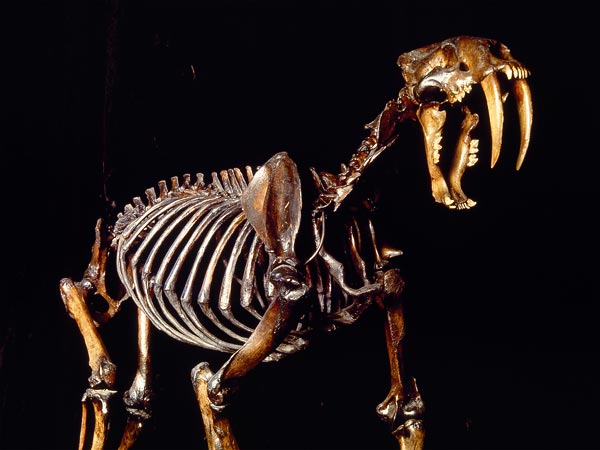Sabertooths Had Weak Bites, Used Neck Muscles to Kill
A skeleton of Smilodon fatalis, an extinct sabertooth cat, modeled after fossils found in the La Brea tar pits in Los Angeles.
At least two species of sabertooths were more muscle than bite, subduing their prey with powerful necks and forelimbs, a new study says.
The long-fanged prehistoric predators "have long excited scholarly and popular attention," particularly in regard to their hunting technique, according to a study published June 26 in the journal PLoS ONE. One question scientists have paid particular attention to was whether the cats ran down prey like lions, dispatching them with a powerful bite to the throat.
Ongoing research has suggested not. For instance, a 2007 study found that North America's saber-toothed cat Smilodon fatalis was a wimpy biter when compared with modern-day lions.
Now a new computer model based on the biomechanics of fossil skulls shows that both Smilodon and a "bizarre," distantly related sabertooth species, Thylacosmilus atrox, had weak jaws but extremely strong neck muscles, which they used to sink their long teeth deep into flesh, according to the study.
The finding sheds light on the evolution of this killing method—one that's arisen several times over the history of life on Earth, said study co-author Lawrence Witmer, a paleontologist at Ohio University. Witmer broke down his research and what we should know about these fearsome beasts.
I don't think most people know there was more than one sabertooth species.
Yes, there were many species of saber-toothed animals—not just saber-toothed cats or the saber-toothed tiger that's well known from the La Brea Tar Pits in Los Angeles. Thylacosmilus atrox isn't a cat at all; it's actually something more closely related to marsupials. This is an animal that probably had a pouch.
Did the sabertooth species interact?
Some of them may have encountered each other. Thylacosmilus lived about seven million years ago in Argentina, and Smilodon lived about two million years ago in North America.
We're living in an unusual time in that there are no sabertooth predatory animals around today. This type of [animal with] long canine teeth used for killing has evolved over and over again in the history of mammals—which is called iterative evolution. We might predict in another 5, 10, or 15 million years, a sabertooth might evolve again. (Watch a video of what a sabertooth might have looked like.)
What's interesting about this study is we're looking at a true cat, Smilodon, compared with the marsupial cousin Thylacosmilus, something that is far removed from pouchless placental mammals. This provides us the opportunity to look at convergent evolution—the independent evolution of similar-looking structures—in this case, long knife-like canine teeth, as well as bony features suggesting low bite force—in different animal groups engaging in similar functions.
What is a biomechanical model and how does it work?
We took these original fossil skulls—which we got on loan—and ran them through a CT scanner. That transfers the sabertooth skulls into a computer environment. We then used different kinds of software, including the kind engineers use to run simulations on the structure of bridges or buildings.
You can apply these to animals to see how the skull models respond to simulated stresses or strains. They're almost like crash tests. One of the things we could model is where the muscles were, and we could make them work digitally. We assigned forces and contraction parameters to make the muscles function like normal jaw muscles to see how the jaw responds. You get these multicolored images that show areas of high and low stress, which indicates what parts were stronger and what parts were weaker.
What were the results?
Both of these sabertooths had relatively weak bites, despite the fact they're using their sabers as killing devices. We looked at the head-depressing muscles—which run from the neck to the head and drive the head down—and found that the animals weren't chomping down on prey, they were driving the teeth into the prey using their neck muscles.
People may think of them being fast runners, but sabertooths were probably ambush predators, with strong forelimbs and necks. We envision these animals subduing prey with their forelimbs, holding them down, and then driving sabers into the flesh with their neck muscles.
The marsupial cousin Thylacosmilus made a much bigger commitment to this way of life—it had a much weaker bite force, and had to use its neck muscles and forequarters as important parts of its killing strategy.
Were you surprised?
People have speculated, but the new piece was comparing the classic sabertooth Smilodon to a specialized marsupial cousin. We often mistakenly view marsupials and their relatives as being sort of primitive kinds of animals because they branched off earlier in evolution. Here we can see Thylacosmilus was in some respects a more highly evolved, sophisticated animal than Smilodon because of its even more specialized killing behavior.
Why do you want to know about how these ancient animals behaved?
Partly because it's part of our job as paleontologists to try to comprehend the history of life on our planet. From a broader perspective, it allows us to look at how evolution works with the raw materials of what came before.
For instance, on the one hand we have Smilodon that evolved into something we'd recognize to be a cat. On the other hand we have the evolution of something very different, Thylacosmilus, which was related more to opossums than cats.
It's also part of a new, groundbreaking way to look at extinct animals by applying engineering techniques—it's another way to look at the past.
Christine Dell'Amore
National Geographic
Published July 2, 2013












